|
|
|
Canary Creek hunter platforms
Tuesday, September 17 2013
This morning I had to take the dogs for their walk, so I ventured into mostly uncharted territory. I walked to the end of the Farm Road and kept going more or less straight, following a ramplike ridge down into the valley that opens up below the Canary Falls. (I call the creek that goes over those falls "Canary Creek" because it crosses Hurley Mountain Road near its southern junction with Canary Hill Road.) The end of the ramplike ridge ends in a sudden cliff adjacent to another set of falls. I found a way down around the cliff and then looked at it from below. It was gorgeous, as was the waterfall, though it was just a thin set of trickles falling into a respectable plunge pool. I took a few photographs, but none of them do any of what I saw justice.
Downstream, the valley opens up as wide and flat-bottomed. It was large enough for me to wonder if perhaps it was a small glacial cirque (which, when I looked later at a map, seemed unlikely). The vegetation there is a classic mesic forest, complete with beautiful old American Beeches that somehow escaped being incised with the inscriptions of bored teenagers.
The dogs and I followed the stream gradually downhill for awhile. Along the way I had to use the facilities (if you will), so of course this meant that I had to build a makeshift cairn on top of my production to keep Ramona from immediately devouring it.
Further down, I found a fairly tall hunter's platform. Its latter was too old and rotted to climb and whole thing was fairly rickety. It's a good thing that I only ever find decrepit hunters' structures in the woods, suggesting hunters are gradually dying off and being replaced by Xbox-playing land whales.
At a certain point downstream, I got to the edge of a clearing, where I could make out a rustic homestead that looked like it might have been built by hippies as part of a back-to-the-land thing. Not wanting the dogs or me to be detected, I turned northward and followed a ridge that formed a natural ridge back up the escarpment. To its east, the clearing continued and a road ran along its edge. That road eventually led to another compound. Based on the vehicles and the fake deer set up for target practice, I judged the people living there to be of a more weaponized hillbilly nature. Further up the natural ramp, I came upon a larger, though still somewhat dilapidated hunter's platform, and then I crossed unexpectedly into land owned by Catskill State Park. It didn't take much climbing of the steep escarpment before I arrived on the terrace where the Stick Trail runs, and that was the means I used to return home.
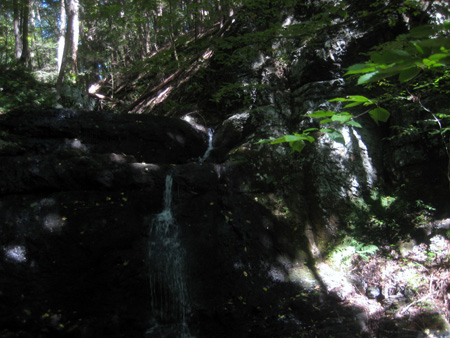
The lower falls and adjacent cliffs where the wide Canary Creek floodplain begins.
(Click to enlarge.)
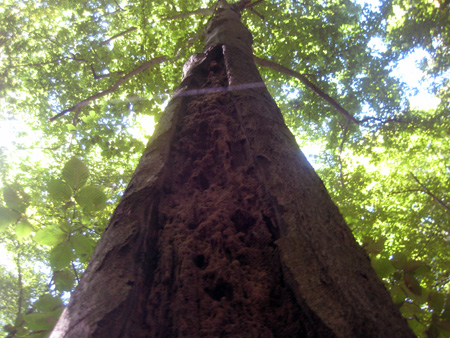
A large beech with no graffiti but with a rot problem.
(Click to enlarge.)
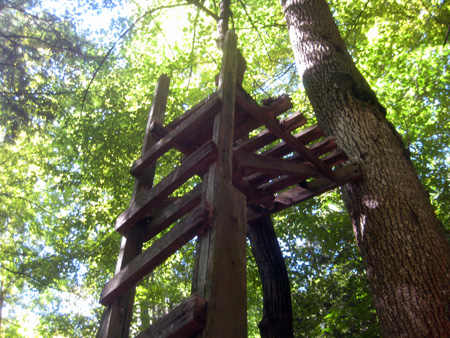
The small hunters' platform.
(Click to enlarge.)
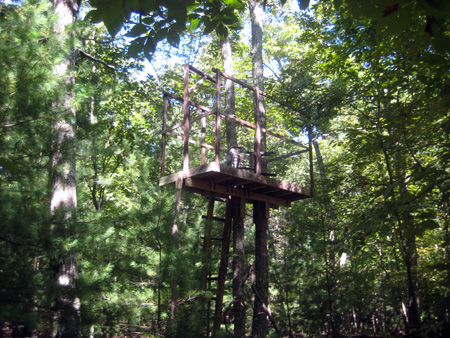
The large hunters' platform.
(Click to enlarge.)
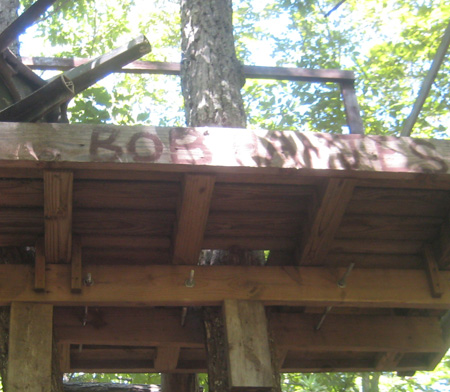
Detail of an inscription on the side of the large hunters' platform.
View Sept 17 2013 Walk in a larger map
A map of today's walk.
The greenhouse upstairs is a great place to hang out, but I've noticed that the WiFi there is flaky-to-nonexistent. I'd tried using a repeater to increase the power of the WiFi signal, but the repeater I'd used was itself flaky, and though I could connect with it, the repeater was often in a state where it wasn't able to communicate with the WiFi router in the house (which is named "cockroach"). Today I decided to solve this problem once and for all by installing a WiFi router above the door to the greenhouse downstairs. About four and half years ago when I was digging the trenches to lay the electrical wire to supply the greenhouse, I anticipated a day when I would need to reach the greenhouse using various forms of communication technology. Not knowing what precisely those technologies would be, I ran four separate Cat 5e cables from the laboratory to the greenhouse. Today I decided to use one of those cables to carry ethernet data to the new wireless router. The cable I chose to use was one that had been dangling unused for years over the door of the greenhouse downstairs. Since it was on the inside of the greenhouse, to put a WiFi router on the outside of the greenhouse meant that I would have to drill a hole. Using a long 3/8 inch bit, I drilled diagonally upward through the door's framework. The hole on the outside appeared just beneath a tiny little roof that protects the door from rain. That little roof has also provided an ideal place for paper wasps to site a nest. Indeed, the nest built there last year was in such a good location that this year wasps reoccupied it, something I'd read that they never do. It's an indication of the docility of paper wasps that I could pull the cable out of a hole in the wall only three inches from their nest. Indeed, before I even had a chance to pull it, I'd pushed the cable through so far that it was actually stabbing the nest, and yet the wasps weren't particularly disturbed. Their passivity might have been partially a function of the cool weather, but it's not as if it wasn't warm enough for them to fly.
Back when I'd buried it in a ditch, I'd been skeptical of the long-term prospects of the Cat-5e cable, even though it was supposedly rated for outdoor exposure. It had lain there unused underground for four and half years, but once I had proper ethernet connectors on both ends, it worked perfectly. Unlike other attempts I'd made at burying Cat-5 cable, for these wires I'd been careful to place the cable in conduit in the places where it emerges from the ground. That's the place where squirrels and possibly other rodents have been known to chew through it.
The WiFi router I installed near the wasp nest was a model onto which, years ago, I'd successfully installed OpenWRT firmware. This means that it has all sorts of fun capabilities, including the ability to host multiple virtual hotspots, each with their own SSIDs. As a lark, I created one named "Pedophile Investigation Unit."
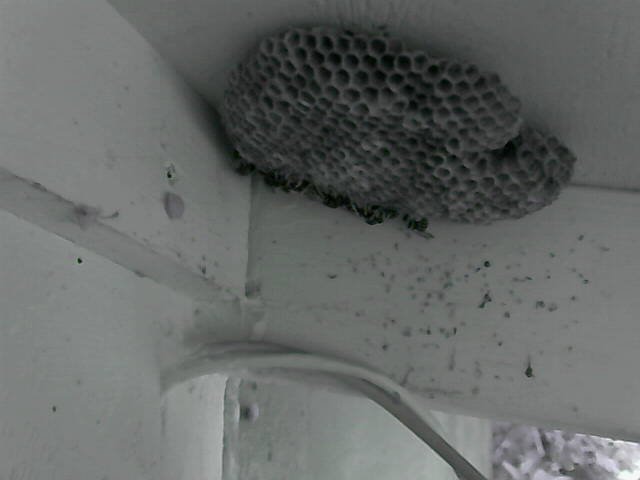
The wasp nest near the cable emerging from the wall above the door to the greenhouse downstairs. [There are actually two cables in this picture, since it was taken on September 18th, after I'd installed another cable to be used some day for carrying temperature probe data.]
For linking purposes this article's URL is:
http://asecular.com/blog.php?130917 feedback
previous | next |





